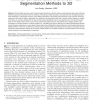Free Online Productivity Tools
i2Speak
i2Symbol
i2OCR
iTex2Img
iWeb2Print
iWeb2Shot
i2Type
iPdf2Split
iPdf2Merge
i2Bopomofo
i2Arabic
i2Style
i2Image
i2PDF
iLatex2Rtf
Sci2ools
PAMI
2010
2010
Minimal Surfaces Extend Shortest Path Segmentation Methods to 3D
—Shortest paths have been used to segment object boundaries with both continuous and discrete image models. Although these techniques are well defined in 2D, the character of the path as an object boundary is not preserved in 3D. An object boundary in three dimensions is a 2D surface. However, many different extensions of the shortest path techniques to 3D have been previously proposed in which the 3D object is segmented via a collection of shortest paths rather than a minimal surface, leading to a solution which bears an uncertain relationship to the true minimal surface. Specifically, there is no guarantee that a minimal path between points on two closed contours will lie on the minimal surface joining these contours. We observe that an elegant solution to the computation of a minimal surface on a cellular complex (e.g., a 3D lattice) was given by Sullivan [47]. Sullivan showed that the discrete minimal surface connecting one or more closed contours may be found efficiently by solv...
Related Content
| Added | 29 Jan 2011 |
| Updated | 29 Jan 2011 |
| Type | Journal |
| Year | 2010 |
| Where | PAMI |
| Authors | Leo Grady |
Comments (0)

